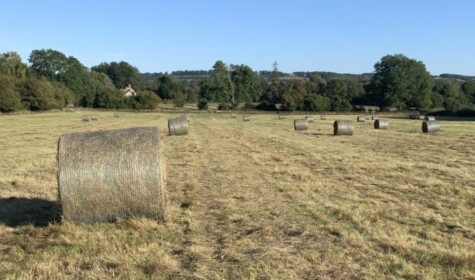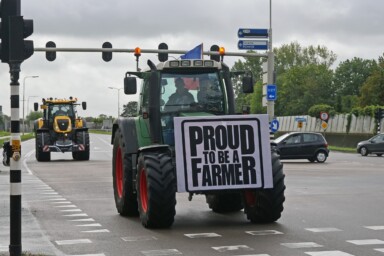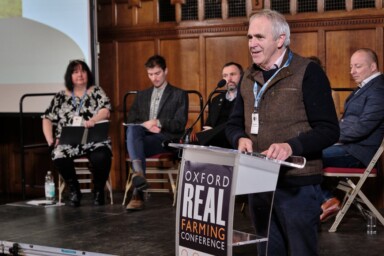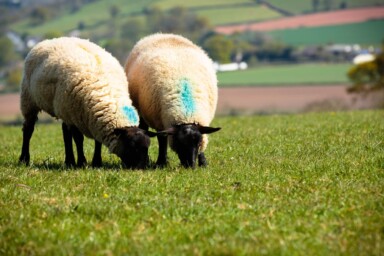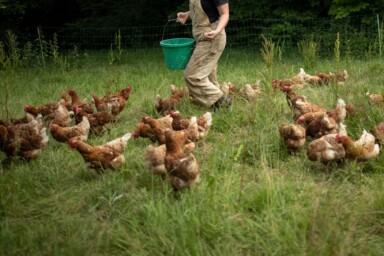Richard Young, at home on the farm and busy haymaking, gives a personal view of why he’s fallen out of love with the Agriculture Bill after initially feeling it was the answer to his prayers.
As I was going round and round and up and down fields we had shut up for hay, mowing the grass earlier this week, I was, of course, looking out for obstacles, the unspotted stone or fallen branch that can break a blade or worse. And I was wondering whether we’ll have enough hay to feed the cattle and sheep through the winter, as the crops are very light this year due to the prolonged spell of dry weather in April and May. But on the straight and easier sections of the field, my mind returned over and over again to the future of the farm itself and how it might – or might not – fare under the huge changes heading towards us, and all UK farmers, over the next six months.
The Agriculture Bill will take over from the Common Agricultural Policy on 1 January 2021, as the principal legislation governing farm support once the Brexit transition period has ended. It relates principally to England, as the devolved nations have scope to develop their own versions. This is expected to cause headaches and unfairness for farmers with land in border regions who may have to cope with different sets of regulations on different fields and potentially see neighbouring farmers financially supported in ways denied to them.
The Bill, now approved by the House of Commons and under consideration by the House of Lords, has come to wider attention in relation to the trade deals the UK is currently negotiating with the US and other countries. A concerted attempt to amend the Bill by Conservative MPs Simon Hoare and Neil Parish was defeated, despite support from about 20 other rebel MPs who defied a 3-line whip and voted with opposition parties. Their amendments sought to force the Government to make good on promises in its election manifesto and elsewhere, not to undermine UK farmers or let down UK consumers by importing food from countries where it is produced to animal welfare and environmental standards that would be illegal in the UK.
Media coverage of these issues almost exclusively focuses on US beef treated with hormones and chicken washed in chlorine bleach. But the concerns are much wider than that. Less attention has been given to the fact that pigs in the US are given ractopamine, a hormone-like feed additive to make them super-lean; that dairy cows are still injected once a fortnight with the milk boosting hormone, bovine somatotropin (rBST); or that widely grown GM crops are sprayed so often with Roundup that three-quarters of rain water and air samples taken in a study by the US Geological Survey contained glyphosate, the main active ingredient. On top of this, several antibiotics with proven growth promoting effects, banned for this purpose in the UK and throughout the EU, are still routinely used in feedlot cattle, ostensibly to control diseases of intensification including coccidiosis, liver abscesses and respiratory infections.
To be fair, some of these antibiotics can also be prescribed by vets in the UK for the same purposes. But US data analysis by the Alliance to Save Our Antibiotics has shown that 8-9 times more antibiotics are used per kilo of beef produced in the US than in the UK, which indicates either that feedlots are very unhealthy places to raise cattle or that the antibiotics are principally being used to increase the rate of growth – or perhaps both.
Even if the Government agrees not to let in hormone-treated beef or chlorine-washed chicken (which it may do) that won’t stop imports of antibiotic-treated feedlot beef or chicken washed in any of half a dozen other chemical washes used in the US to reduce the bacterial contamination of chicken, reared in conditions we don’t allow in the UK.
This will put UK farmers at a huge competitive disadvantage and create pressure to dilute standards in the UK and make a mockery of the Government’s claim that the Bill will result in higher welfare standards. This has brought a common purpose to environmental and animal welfare groups who warmly welcomed the ‘public money for public goods’ approach, and farming organisations which have been concerned by the complete absence of support for food production in the Bill.
Why the Agriculture Bill was warmly welcomed
Almost all environmental organisations welcomed the Bill and I supported it too. You might wonder why?
A few days after the Bill was first published in September 2018, Defra released a short video, presenting a rose-tinted vision of what the new bill would deliver. This is just one of many ways the upbeat message was spread about the bright future and exciting new opportunities that awaited UK farmers and consumers alike, once we had left the EU.
The promise that, in future, public money would only be paid to farmers for public goods seemed sensible. I didn’t initially realise that economists are adamant that, no matter how it is produced, food is not a public good, because it has a market value. Even within their own narrow terms they are wrong, in my view, because the market does not fully reward farmers who produce nutritionally superior food and there is mounting evidence that nutritionally depleted food contributes to diet-related disease, the cost of which is partly met out of the NHS budget.
One of Defra’s reports, published at the same time, ‘Agriculture Bill: Analysis and Economic Rationales for Government Intervention’, builds on the impression created by the video with a detailed and compelling case for change. The negative aspects of intensive agriculture are presented as a consequence of the Common Agricultural Policy. In 2015, the report states, agriculture was responsible for 10% of UK greenhouse gas emissions at a cost of £3 billion and 81% of the UK’s ammonia emissions at a cost of £456 million. It puts the cost of soil erosion at £305 million and then moves on to biodiversity loss, adding, ‘There has been a sustained decline in diversity across plant, animal and insect species, attributable to changing land use and intensive agricultural production’. It goes on to mention the 50% decline in farmland birds, 18% decline in woodland birds and 57% decline in butterfly populations since 1970, the year before we voted to join the EEC. The wording and the statistics could have been lifted from the SFT’s ‘Hidden Cost of UK Food’ report, or from a number of other reports by Compassion in World Farming and the Soil Association, for example.
Not content with that, Defra’s new green credentials seem even more solid when it then turns to water pollution from agricultural fertilisers and how this degrades rivers and lakes and increases household water bills. It points to the Environment Agency’s conclusion that in 2013, ‘diffuse pollution from agriculture is the likely cause of 31% of failures of water bodies to meet “good” status’. It then cites one of its own reports which concludes that ‘50% of nitrate pollution, 25% of phosphate in the water environment and 75% of sediment pollution still comes from farming’. It then adds that, ‘gains in agricultural productivity have largely been at the expense of wildlife and pollinators because they do not have a market value’. My assumption, therefore, was that the Agriculture Bill would herald in a food system where all of these problems would be a thing of the past.
Why I cared
I joined the Soil Association and converted a 200-acre Cotswold farm to organic in 1974 (the year after we joined the Common Market) with little initial understanding of organic husbandry, simply by stopping all further use of pesticides and artificial fertilisers. I had very quickly become disillusioned by the way intervention buying inflated the price of grain so rapidly that my neighbouring farmers were almost all abandoning traditional arable rotations, which generally included a 2-year grass ley break crop, ploughing every field they could in order to grow grain continuously and then burning the straw in the field. Almost immediately fungicides were being used for the first time in our area to control a big increase in fungal diseases in barley, and in the following year insecticides were being spayed by aircraft in a counter-productive attempt to control an invasion of aphids on wheat – counter-productive because the early products also killed off ladybirds, the aphids’ main predator.
When I first read about the Agriculture Bill, I was inspired by Defra’s new vision, but I bought into the spin rather than the reality. I only read those sections of reports that re-enforced what I wanted to believe, yet some of the wording does now appear seriously misleading. Reference to whole farm management agreements has been dropped and the claim in the influential but now withdrawn, ‘Health and Harmony paper’ that Defra ‘will support farmers to provide more home grown, healthy produce’ sounds hollow, now we know there will be no support for food production in England once basic payments have been phased out.
Has the Government used propaganda techniques to influence attitudes towards the Agriculture Bill?
According to Wikipedia, propaganda is ‘often associated with material prepared by governments’ and is ‘communication that is used primarily to influence an audience and further an agenda…. and may be presenting facts selectively to encourage a particular synthesis or perception’.
It’s perhaps so obvious that it hardly needs stating, but the most ironic thing about the Agriculture Bill, the first since 1947, is that despite the impression given, it is not about agriculture or food production at all. Similarly, the Environmental Land Management Schemes which Defra is developing and plans to use as the main vehicle for future farm schemes, are not going to be about the environmental management of all farmland, or even most farmland, despite the impression given in Defra’s video. Instead, as far as I can judge from the limited amount Defra has said, these will largely relate to areas of land taken out of food production. And in the new, food production subsidy-free world we are about to enter, it is widely expected that many English farmers will be forced to farm even more intensively than they have done in the past in order to compete, unsupported on world markets, against farmers in the US and EU (or even, perhaps with farmers in one of the devolved UK nations) who may be still receiving subsidies to help them produce food. Defra uses words like ‘more competitive’ and ‘more productive’ but what it means by this is that most food producing land will be farmed more intensively, while only those farmers using the latest technologies will survive.
The biggest shock
While Defra talks about the Bill supporting farmers, it is now totally clear that the Government expects a large number of family farms to go out of business as a result of the switch from the CAP to the Agriculture Bill. While its publications lead on the fact that, on average, direct payments to farmers account for only 9% of the money going into farms, deeper in the reports you find acknowledgement that direct payments (of which basic payments make up the lion’s share) actually account for 94% of the profit of lowland grazing livestock farms and 91% of the income of farms in less favoured areas. What distorts the averages is that intensive poultry farms make average profits of £112,000 but direct payments account for just 8% of this.
In my own case, we receive just under £27,000 a year in Basic Payments on a 390-acre farm, 100 acres of which is woodland that receives no support and the rest mostly steeply-sloping grassland. We will continue to receive a further £16,000 a year for three more years, mostly from the Higher Level Stewardship scheme which requires us to have very low stocking levels and encourage wild flowers by not making hay in the subsidised fields until after 15 July each year, by which time it has little goodness in it. It’s possible that one of the ELM schemes will continue that type of support, but the basic payments part alone is more than twice our annual profit in a good year. That’s the entire farm and farm butcher’s shop profit for two people (my sister and her partner) who work long hours, 365 days a year and me, who does a certain amount on the farm at weekends and during peak periods.
And our situation is fairly typical. Defra cites figures showing that English lowland grazing livestock farms had an average income of £15,500 in 2016 (an income that has since fallen to £12,500).
At one level it’s not hard to see why Defra feels that farmers like us should either go out of business or do something with our land that would generate more income. If we opened it to the public, no doubt, in the popular tourist area where we live, the money would roll in. Not all farmers live in such favoured locations though and not all farms have the skills or the heart to do this. We have a technically successful mixed farm with happy and healthy livestock and flourishing wildlife. We also have a large and increasing number of customers who want our organic, 100% grass-fed meat because they know how it is produced. But they are not the super-rich. They can’t afford to pay top prices. The reason that farmers like us struggle to make a living is because to be as environmentally sustainable as we can, costs us extra. In addition, our costs keep rising, not least because all our local abattoirs have closed and we have to take our livestock to slaughter and then have the meat brought back much greater distances. Other costs have also risen dramatically, but the prices we get for our produce, like UK food prices, have only crept up slightly, recent prices for cull cows, for example, have been almost exactly the same as in 1995.
If the changing system of farm support drives more cattle farmers and maybe also some sheep farmers out of business, as seems inevitable, the shortfall in production will be made up by increased imports. The UK already imports a quarter of its beef. One of the objectives of the Bill is to help address climate change, yet on average the carbon footprint of beef produced in other countries (see Tables 1 & 2) is more than double that of beef produced in the UK. A significant amount of Brazilian beef, for example, is produced on former rainforest land where research shows that the carbon footprint of a kilo of beef is over 700 kg CO2. That’s more than 20 times higher than average UK beef production. The UK already imports over 25,000 tonnes of Brazilian beef each year. If we import even more it will simply add to the pressure to clear more rainforest for more cattle. Getting rid of UK cattle and importing more beef may help the Government to meet its net zero carbon by 2050 target, but in reality this will increase, not reduce, global warming.
So, why is the Government so keen to abandon grazing livestock farmers? Is it due to vegan campaigns or because importing more beef into the UK will be make or break for several post-Brexit trade deals? Or is it because, despite a series of reforms, the CAP’s way of supporting food production and making sure we always had enough, never lost the bad name it acquired early on, while UK tax payers have been led to believe they are paying huge amounts to feather bed farmers in the UK?
Do you know how much it costs the average citizen? Direct payments to UK farmers were over £3 billion in 2016 (the year Defra cites in its reports), a fraction under £50 per head per year for the whole population, but English farmers received £1.65 billion of that, equivalent to under £30 per head of the English population. If you don’t believe me, use a calculator to divide £1.65 billion by 56 million (the English population)! But this, sadly wouldn’t be enough to support all the (admittedly important) environmental projects set out in the Bill and leave enough to get all farmers adopting more sustainable methods, which is why some farmers have already indicated they are unlikely to join any of the ELM schemes and believe they will need to farm at full throttle on their most productive land to compete on world markets.
So, it seems to me that the Government has chosen to rely even more on imported food from countries where wages and production standards are lower and let market forces drive grazing livestock and even some arable farmers out of business, while actually giving another twist to the spiral of farm intensification. Is it a coincidence that influential Treasury advisor and friend of Dominic Cummings, Tim Leunig, believes we don’t need farmers or fishermen in the UK at all? Might he even be the mastermind behind the Agriculture Bill?
The House of Lords will be considering the Bill again in early July. We most hope they can make some important changes. Either way, however, peers won’t be able to correct the fundamental weaknesses of the Bill. One day, either weather extremes or yet another virus will disrupt the supply of imported food. I feel we may then look back and realise that the CAP, still far from perfect but continually reforming, had a better model to ensure food security and reasonable prices, while genuinely striving to increase sustainability and reduce global warming. And we could have adopted that model outside the EU and improved it, rather than choosing the precarious and very uncertain path we are on.
For now, I’ll continue to make hay when the sun shines and try to avoid the obstacles to staying in business, but I can’t help wondering for how many more haymaking seasons our farm will remain financially viable.
